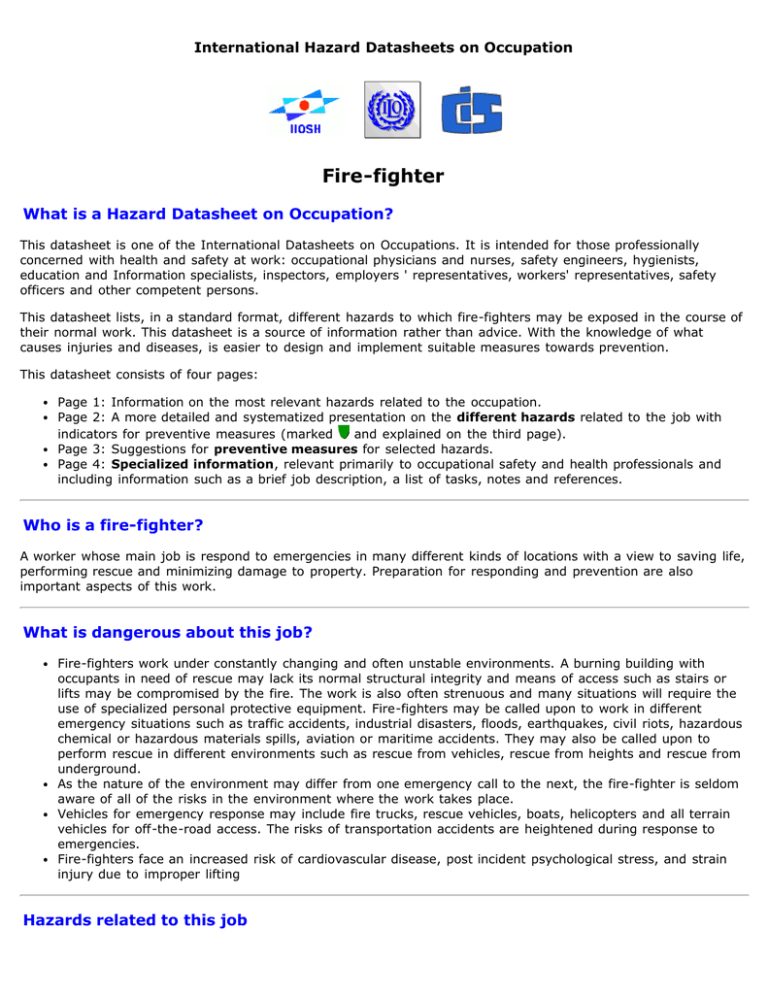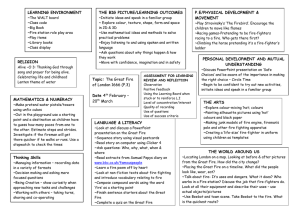Occupational Hazard Datasheets - Fire-fighter
advertisement

International Hazard Datasheets on Occupation Fire-fighter What is a Hazard Datasheet on Occupation? This datasheet is one of the International Datasheets on Occupations. It is intended for those professionally concerned with health and safety at work: occupational physicians and nurses, safety engineers, hygienists, education and Information specialists, inspectors, employers ' representatives, workers' representatives, safety officers and other competent persons. This datasheet lists, in a standard format, different hazards to which fire-fighters may be exposed in the course of their normal work. This datasheet is a source of information rather than advice. With the knowledge of what causes injuries and diseases, is easier to design and implement suitable measures towards prevention. This datasheet consists of four pages: Page 1: Information on the most relevant hazards related to the occupation. Page 2: A more detailed and systematized presentation on the different hazards related to the job with and explained on the third page). indicators for preventive measures (marked Page 3: Suggestions for preventive measures for selected hazards. Page 4: Specialized information, relevant primarily to occupational safety and health professionals and including information such as a brief job description, a list of tasks, notes and references. Who is a fire-fighter? A worker whose main job is respond to emergencies in many different kinds of locations with a view to saving life, performing rescue and minimizing damage to property. Preparation for responding and prevention are also important aspects of this work. What is dangerous about this job? Fire-fighters work under constantly changing and often unstable environments. A burning building with occupants in need of rescue may lack its normal structural integrity and means of access such as stairs or lifts may be compromised by the fire. The work is also often strenuous and many situations will require the use of specialized personal protective equipment. Fire-fighters may be called upon to work in different emergency situations such as traffic accidents, industrial disasters, floods, earthquakes, civil riots, hazardous chemical or hazardous materials spills, aviation or maritime accidents. They may also be called upon to perform rescue in different environments such as rescue from vehicles, rescue from heights and rescue from underground. As the nature of the environment may differ from one emergency call to the next, the fire-fighter is seldom aware of all of the risks in the environment where the work takes place. Vehicles for emergency response may include fire trucks, rescue vehicles, boats, helicopters and all terrain vehicles for off-the-road access. The risks of transportation accidents are heightened during response to emergencies. Fire-fighters face an increased risk of cardiovascular disease, post incident psychological stress, and strain injury due to improper lifting Hazards related to this job Specific preventive measures can be seen by clicking on the respective Accident hazards in the third column of the table. Falls from heights during ladder work Falls from heights due to collapsing structures Struck by falling objects during rescue, fire-fighting operations, or salvage operations Stepping on, struck by or striking against glass, metal or other sharp objects leading to cuts or scratches, including injuries due to explosions Caught in collapsing or collapsed structures Overexertion in lifting during fire-fighting or rescue operations Contact with hot surfaces or superheated gases Inhalation of superheated air and/or products of combustion Contact with or exposure to chemical products during fire-fighting, rescue or hazardous chemical spill operations Interruption of air supply during fire-fighting operations Injuries due to transportation accidents in responding to an emergency. Slips, trips and falls on the fire-ground Physical hazards Collapse of ceilings, walls or floors Sudden ignition of gas products "flashover." Exposure to heat leading to burns Exposure to heat leading to heat stress Exposure to cold during winter fire-fighting or rescue operations or during maritime rescue operations Exploding objects on the fire-ground Exposure to noise in vicinity of pump or other equipment Chemical hazards Inadequate oxygen in the breathing air The presence of carbon monoxide gas and other products of combustion in the breathing air Exposure to chemicals during chemical emergencies Biological hazards Exposure to communicable diseases while treating patients as part of emergency medical related activities Ergonomic, psychosocial and organizational factors Psychological stress due to post traumatic stress syndrome Overexertion and musculo-skeletal injuries while handling or moving heavy or awkward objects such as fire hoses, specialized rescue equipment while wearing heavy personal protective equipment. Preventive measures Use a ladder hook when working on ladders. Use appropriate fall protection equipment when working at heights. Use a full personal protective equipment "envelope" including self contained breathing apparatus. Use personal alert safety systems to alert other fire-fighters in the vicinity. Maintain an adequate level of fitness and observe the proper rules for safe lifting and carrying. Provide for adequate rotation and breaks during the active stages of rescue, fire suppression and overhaul. Use proper restraining devices such as seat belts and harnesses during transportation. Use appropriate personal protective equipment relative to the hazard. Attend critical event debriefings and seek individual counseling when appropriate. Specialized information Synonyms Fireman, fire brigade personnel, fire department personnel Definitions Controls and extinguishes fires, protects life and property, and maintains equipment as volunteer or employee of city, township, or industrial plant: Responds to fire alarms and other emergency calls. and/or description Selects hose nozzle, depending on type of fire, and directs stream of water or chemicals onto fire. Positions and climbs ladders to gain access to upper levels of buildings or to assist individuals from burning structures. Creates openings in buildings for ventilation or entrance, using ax, chisel, crowbar, electric saw, core cutter, and other power equipment. Protects property from water and smoke by use of waterproof salvage covers, smoke ejectors, and deodorants. Administers first aid and artificial respiration to injured persons and those overcome by fire and smoke. Communicates with superior during fire, using portable two-way radio. Inspects buildings for fire hazards and compliance with fire prevention ordinances. Performs assigned duties in maintaining apparatus, quarters, buildings, equipment, grounds, and hydrants. Participates in drills, demonstrations, and courses in hydraulics, pump operation and maintenance, and fire-fighting techniques. May fill fire extinguishers in institutions or industrial plants. May issue forms to building owners, listing fire regulation violations to be corrected. May drive and operate fire-fighting vehicles and equipment. May be assigned duty in marine division of fire department and be designated Firefighter, Marine (any industry). (US Dictionary of Occupational Titles Ref. 373.364-010) Related and Fire investigator; fire-fighter, aircraft accidents; fire-fighter, forest; salvage man-fire; salvage specific woman-fire; inspector, fire; investigator, fire; specialist, fire prevention; fire-fighter, industrial; fire occupations officer. Tasks Adjusting; applying (water); climbing; controlling (fire); controlling (fuel); controlling (oxygen); coordinating; driving; evaluating (scene); extinguishing; evacuating (people); fueling; handling (lines); handling (hoses); handling (ladders); lifting; loading; maintaining; observing; operating; positioning; repairing; rescuing; salvaging; searching; storing; training Primary equipment used Axes; cutting tools; fire apparatus; fire extinguisher; first aid equipment; ladder belt and hook; ladders; oxygen administration equipment; personal alert safety system; protective chemical suit; protective coat; protective gloves; protective helmet; protective shoes; protective trousers; prying tools; pumps; ropes; salvage covers; self contained breathing; apparatus; smoke ejectors; face shield; two-way radio Workplaces Working environment during non-emergency activities is normally the fire station or a specialized where the fire training ground. The work place for emergency operations is totally variable, depending on the occupation nature of the emergency. is common Notes Fire-fighting is a very high risk occupation. Both occupational injuries and occupational diseases can lead to disability and death. The fact that the working environment during emergencies is hostile and unpredictable and that the fire-fighter cannot be prepared for every eventuality requires a growing level of sophistication in training and education and the development of personal protective equipment to protect the fire-fighter from the hazards of the job. The National Fire Protection Association publishes a standard (NFPA 1500) which encourages an occupational safety and health programme for fire departments with a view to reduce occupational accidents, injuries and fatalities. This standard encompasses issues such as fire department safety officers, an occupational safety and health committees, data-collection systems, basic training requirements, inspection of fire apparatus and equipment, the use of personal protective equipment including self contained breathing apparatus, the management of the emergency scene and the fitness of fire-fighters. References Guidotti, T: Firefighting Hazards, in Stellman, J. (Ed) The ILO Encyclopaedia of Occupational Health and Safety, 4th Edition, ILO Geneva, 1998. Vol 3. pp 95.4-9. Teele, B. (Ed) NFPA 1500 Handbook, National Fire Protection Association, Quincy (MA), 1993. Updated by the HDOEDIT (© ILO/CIS, 1999) program. Approved by DG. Last update: 19.05.2000.

